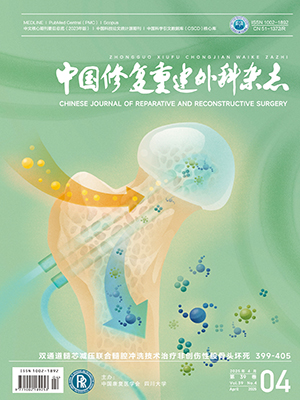| 1. |
Yang H, Liu H, Wang S, et al. Review of percutaneous kyphoplasty in China. Spine (Phila Pa 1976), 2016, 41 Suppl 19: B52-58.
|
| 2. |
Yimin Y, Zhiwei R, Wei M, et al. Current status of percutaneous vertebroplasty and percutaneous kyphoplasty-a review. Med Sci Monit, 2013, 19: 826-836.
|
| 3. |
Lamy O, Uebelhart B, Aubry-Rozier B. Risks and benefits of percutaneous vertebroplasty or kyphoplasty in the management of osteoporotic vertebral fractures. Osteoporos Int, 2014, 25(3): 807-819.
|
| 4. |
刘小勇, 杨惠林, 唐天驷, 等. 椎体后凸成形术棘突定位穿刺点与穿刺轨道的研究. 中华骨科杂志, 2005, 25(8): 462-466.
|
| 5. |
Wang S, Wang Q, Kang J, et al. An imaging anatomical study on percutaneous kyphoplasty for lumbar via a unilateral transverse process-pedicle approach. Spine (Phila Pa 1976), 2014, 39(9) :701-706.
|
| 6. |
杨惠林, 王根林, 郑召民, 等. 椎体后凸成形术中椎管内骨水泥渗漏的探讨. 中华创伤骨科杂志, 2008, 10(12): 1105-1107.
|
| 7. |
陈兵, 沈惠良, 张庆明, 等. PKP 术中发生骨水泥渗漏的危险因素及应对策略. 中国骨与关节损伤杂志, 2011, 26(11): 1026-1027.
|
| 8. |
郑召民. 经皮椎体成形术和经皮椎体后凸成形术灾难性并发症——骨水泥渗漏及其预防. 中华医学杂志, 2006, 86(43): 3027-3030.
|
| 9. |
罗鹏明, 王新虎, 左春光. PVP 与 PKP 并发症原因分析及预防. 实用骨科杂志, 2014, 20(5): 398-400.
|
| 10. |
曹林虎, 谭伦, 林旭, 等. 光电导航系统引导经皮椎弓根螺钉内固定术治疗胸腰椎骨折近期疗效观察. 中国修复重建外科杂志, 2016, 30(6): 726-731.
|
| 11. |
卢小刚. 椎弓根穿刺椎体后凸成形术后穿刺通路的 CT 评价. 泸州: 西南医科大学, 2015.
|
| 12. |
廖旭昱, 周雷杰, 马维虎, 等. 经皮椎体后凸成形术中单侧经椎弓根穿刺角度与骨水泥分布情况的关系. 临床骨科杂志, 2012, 15(3): 241-244.
|
| 13. |
Marlin E, Nathoo N, Mendel E. Use of percutaneous kyphoplasty and vertebroplasty in spinal surgery. J Neurosurg Sci, 2012, 56(2): 105-112.
|
| 14. |
阳春华. 单侧与双侧 PKP 治疗骨质疏松性胸腰椎压缩性骨折疗效比较. 湖南师范大学学报 (医学版), 2014, 11(2): 62-64.
|
| 15. |
申勇, 刘法敬, 张英泽, 等. 单、双侧经皮椎体后凸成形术治疗骨质疏松性椎体压缩骨折的疗效. 中国脊柱脊髓杂志, 2011, 21(3): 202-206.
|
| 16. |
朱仰义, 章年年, 任伟峰. 单侧与双侧穿刺 PKP 术治疗骨质疏松性椎体压缩性骨折的疗效比较. 中华全科医学, 2014, 12(12): 1941-1944.
|
| 17. |
Liebschner MA, Rosenberg WS, Keaveny TM. Effects of bone cement volume and distribution on vertebral stiffness after vertebroplasty. Spine (Phila Pa 1976), 2001, 26(14): 1547-1554.
|
| 18. |
Chen BL, Li YQ, Xie DH, et al. Comparison of unipedicular and bipedicular kyphopbsty on the stiffness and biomechanical balance of compression fractured vertebrae. Ear Spine J, 2011, 20(8): 1272-1280.
|




